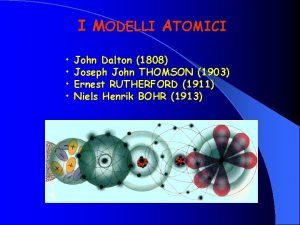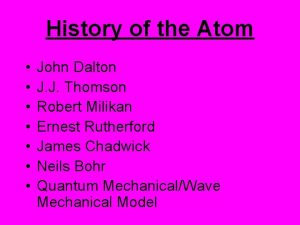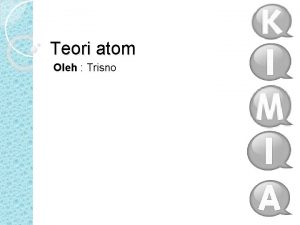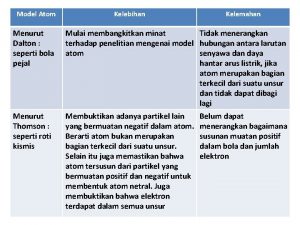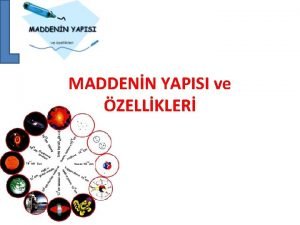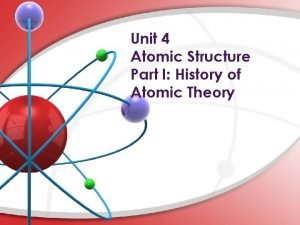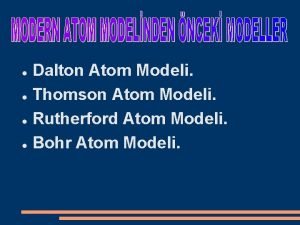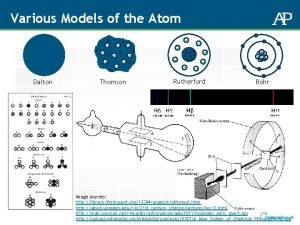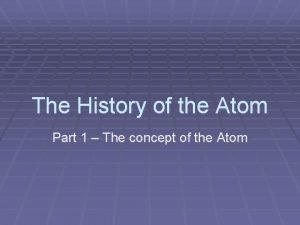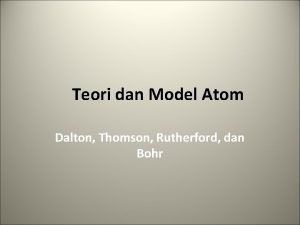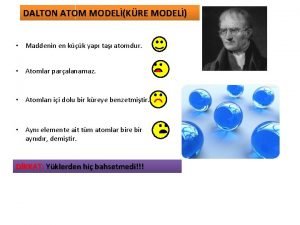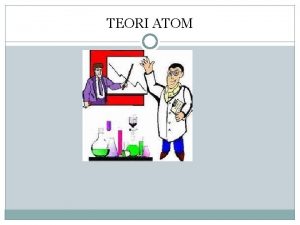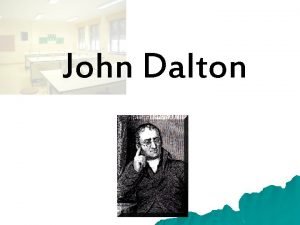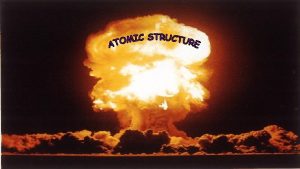HISTORY OF THE ATOM 1808 John Dalton SOLID














- Slides: 14


HISTORY OF THE ATOM 1808 John Dalton SOLID SHPERE MODEL • suggested that all matter was made up of tiny spheres that were able to bounce around with perfect elasticity and called them ATOMS

HISTORY OF THE ATOM 1898 Joseph John Thompson PLUM PUDDING OR RAISIN BUN MODEL • Conducted Cathode ray tube experiment • found that atoms could sometimes eject a far smaller negative particle which he called an ELECTRON

HISTORY OF THE ATOM 1904 Thompson develops the idea that an atom was made up of electrons scattered unevenly within an elastic sphere surrounded by a soup of positive charge to balance the electron's charge like plums surrounded by pudding. PLUM PUDDING / RAISIN BUN MODEL

HISTORY OF THE ATOM 1910 Ernest Rutherford EMPTY SPACE MODEL • Performed the GOLD FOIL EXPERIMENT and discovered NUCLEUS

HISTORY OF THE ATOM helium nuclei gold foil Gold foil experiment He fired Helium nuclei at a piece of gold foil which was only a few atoms thick. They found that while most of the helium nuclei passed through the foil, a small number were deflected and, to their surprise, some helium nuclei bounced straight back.

HISTORY OF THE ATOM Rutherford’s new evidence allowed him to propose a more detailed model with a central nucleus. He suggested that the positive charge was all in a central nucleus. With this holding the electrons in place by electrical attraction However, this was not the end of the story.

HISTORY OF THE ATOM 1913 Niels Bohr ORBIT MODEL / PLANETARY MODEL studied under Rutherford at the Victoria University in Manchester. Bohr refined Rutherford's idea by adding that the electrons were in orbits. Rather like planets orbiting the sun. With each orbit only able to contain a set number of electrons.

Bohr’s Atom electrons in orbits nucleus

HELIUM ATOM Shell proton + - N N + electron What do these particles consist of? - neutron

1920’s Electron Cloud Model Discovered by Erwin Schrödinger and Werner Heisenberg. They said an atom consists of a dense nucleus and many proton and neutrons and is surrounded by electrons, but they all have different energy levels, and different charges.

ATOMIC STRUCTURE He 4 2 Atomic mass the number of protons and neutrons in an atom Atomic number the number of protons in an atom number of electrons = number of protons

ATOMIC STRUCTURE Electrons are arranged in Energy Levels or Shells around the nucleus of an atom. • first shell a maximum of 2 electrons • second shell a maximum of 8 electrons • third shell a maximum of 18 electrons

ATOMIC STRUCTURE Particle Charge Mass proton + ve charge 1 neutron No charge 1 electron -ve charge nil
 Atomic model 1808
Atomic model 1808 John modelli
John modelli History of the atom john dalton
History of the atom john dalton Principio de dirac jordan
Principio de dirac jordan Bunyi teori atom thomson
Bunyi teori atom thomson Kelebihan atom john dalton
Kelebihan atom john dalton John dalton atom modeli
John dalton atom modeli Dalton atom modeli
Dalton atom modeli Dalton rutherford thomson bohr
Dalton rutherford thomson bohr Teori atom dalton
Teori atom dalton Dalton atom modeli maketi
Dalton atom modeli maketi Teori atom dalton thomson rutherford bohr
Teori atom dalton thomson rutherford bohr Atom dalton
Atom dalton üzümlü kek atom modeli
üzümlü kek atom modeli Dalton atom modeli maketi
Dalton atom modeli maketi

